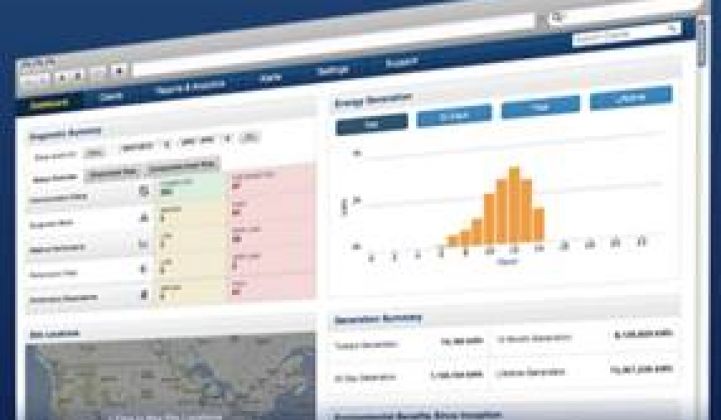“What is unique about our service,” explained Locus Energy VP Adrian De Luca, “is that we take that data and combine it with proprietary analytics.”
Computer screen dashboards that monitor renewable energy systems and report field data are now commonplace. Locus Energy believes it has an edge there.
There are four key components to those proprietary analytics, De Luca said: virtual irradiance, an expected performance model, a waterfall analysis and the forecasting of solar output.
These analytics are enhanced by the feedback of data from the more than 15,000 solar systems to which Locus Energy has access.
With that data and its assessment of satellite meteorological imagery, explained Locus Energy Product and Analytics Manager Alex Thornton, Locus can “evaluate how a system is performing compared to expectations and how it is performing compared to other systems.”
“Virtual irradiance,” said De Luca, “is a calculation engine that runs every fifteen minutes and will tell the user how much sunlight is hitting the ground anywhere in the continental U.S. with a one-kilometer-by-one-kilometer resolution.”
Companies like 3Tier and Clean Power Research use the same publicly available NASA satellite imagery to determine solar irradiance, De Luca said. But they offer standalone data sets, whereas Locus integrates that with its data from those 15,000 sites, which essentially act as solar sensors and tell the Locus system how accurate its calculations are.

“Our tool estimates how much electricity the PV system should produce from the amount of sun hitting the ground and compares it to how much is being produced,” Thornton said. “Using those two together gives a much better idea than other providers that don’t have the ground sensor network.”
Another group of companies provide dashboards with solar performance data. They include, De Luca said, “Power One (NASDAQ:PWER), which bought two of the original providers, Fat Spaniel and Energy Recommerce, Draker, which focuses on commercial and utility systems, DECK Monitoring, and Also Energy." None, he said, have Locus Energy’s reach.
Locus Energy began building its 15,000-solar-sensor network when it was chosen by the state of Connecticut to install smart meters in 1,000 homes participating in a very early solar system third-party-ownership (TPO) financing plan. That was 2008. At present, Locus data source partners are many of the leading TPO players, including Clean Power Finance and Sungevity, as well as major solar builders and suppliers, including NRG Energy (NYSE:NRG) and Dow PowerHouse (NYSE:DOW), and electronics providers, including Tigo and Growatt.
The expected performance model is a formula, De Luca said. Like comparable formulas developed by NREL and PVsyst, it combines irradiance with a range of system details to produce an expected power output in kilowatts.
“What is different about the Locus formula,” he explained, "is that every five minutes, as we get a reading from the field, we also generate an identical value for expected performance, and so there is a constant true-up of what happened and what should have happened.”
The system’s Waterfall Analysis uses a range of algorithms and empirical models to identify which of a set of six factors is causing a difference between a system’s expected and measured performances.

The six factors are: weather uncertainty, snow downtime, shading, equipment downtime, equipment degradation, inverter clipping, and other causes. The calculation is made because the system can recognize and distinguish between the performance deviation profile of each of the factors.
“The six factors represent the most likely sources of losses, the low-hanging fruit,” Thornton said. “There may in the future be ten or twenty measures.”
The system’s ability to identify specific causes of performance deviation has been tested over about a year on ten PV installations. It is not necessarily a statistically valid sampling that unequivocally proves the efficacy of the Waterfall Analysis, Thornton acknowledged, but “we are confident in the output it is giving.”
Such an analysis could make a critical difference in solar industry operations and maintenance, De Luca noted. “The industry is still grasping at straws on the most efficient way to look at performance data and decide whether it is worth the time to send someone into the field,” he said.
More data may not mean more economic decision-making, he acknowledged. “But right now, the decision is based on limited data. This will help inform that decision.”
The forecasting of solar output does with forecasting data what the expected performance model does with historical data. “The models we currently have go to ten days out,” De Luca said.
But the analysis is based on three different sets of meteorological data, Thornton noted, one for up to six hours ahead, one from six hours to ten days ahead and a basic weather report for beyond ten days.
The Locus Energy service is sold in different ways, De Luca said. The newest generation of the core smart meter hardware and a five-year software license is $600. Utility-scale systems can be $10,000 or more.
“Our systems can run on a single solar panel on a utility pole in the middle of nowhere,” De Luca said, “all the way up to utility scale. We are not just aggregating rooftop system information. More of our revenue now comes from commercial and utility scale.”



